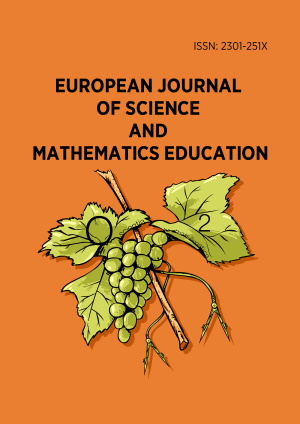Review Article
Mathematics problem-solving research in high school education: Trends and insights from the Scopus database (1983–2023)
More Detail
1 Dong Thap University, Dong Thap, VIETNAM2 Vietnam Journal of Education, Hanoi, VIETNAM3 VNU University of Education, Hanoi, VIETNAM4 Quang Nam University, Quang Nam, VIETNAM5 Thai Nguyen University of Education, Thai Nguyen, VIETNAM6 Xaysomboun High School, Xaysomboun, LAOS7 An Giang University, An Giang, VIETNAM8 Vietnam National University Ho Chi Minh City, VIETNAM* Corresponding Author
European Journal of Science and Mathematics Education, 13(2), April 2025, 77-89, https://doi.org/10.30935/scimath/16038
Published Online: 24 February 2025, Published: 01 April 2025
OPEN ACCESS 4193 Views 3985 Downloads
ABSTRACT
Problem-solving competency is crucial for social development, especially in complex environments. In mathematics education, problem-solving enhances logic, creativity, and analytical skills, contributing to societal progress. This article identified quantitative information about important publications, authors, resources, and research trends on mathematics problem-solving in high school education using the bibliometric analysis method. The input data is a set of 334 publications from the Scopus database published over four decades from 1983 to 2023. The results show that this field has obtained increasing interest, particularly in the last five years, with the USA and Indonesia being the countries with the most publications and Santos-Trigo and Putri Rii being the most influential authors. Three research trends include problem-solving in teaching mathematics in high schools, especially in teaching geometry and algebra; developing problem-solving and computational thinking skills through STEM education, engineering education, and educational computing for students; and using information technology to solve mathematics problems. These results provide teachers and researchers with helpful information about solving mathematical problems in general education, thereby contributing to shaping and proposing effective research and educational strategies, new teaching methods, training programs, and appropriate educational policies.
CITATION (APA)
Cuong, L. M., Tien-Trung, N., Ngu, P. N. H., Vangchia, V., Thao, N. P., & Thao, T. T. P. (2025). Mathematics problem-solving research in high school education: Trends and insights from the Scopus database (1983–2023). European Journal of Science and Mathematics Education, 13(2), 77-89. https://doi.org/10.30935/scimath/16038
REFERENCES
- Aleven, V., Koedinger, K. R., Colleen Sinclair, H., & Snyder, J. (1998). Combatting shallow learning in a tutor for geometry problem solving. In V. J. Goettl, B. P. Halff, H. M. Redfield, C. L. Shute (Eds.), Intelligent tutoring systems. ITS 1998. Lecture notes in computer science (pp. 364–373). Springer. https://doi.org/10.1007/3-540-68716-5_42
- Aria, M., & Cuccurullo, C. (2017). Bibliometrix: An R-tool for comprehensive science mapping analysis. Journal of Informetrics, 11(4), 959–975. https://doi.org/10.1016/j.joi.2017.08.007
- Barana, A., Marchisio, M., & Miori, R. (2019). MATE-BOOSTER: Design of an e-learning course to boost mathematical competence. In Proceedings of the 11th International Conference on Computer Supported Education (pp. 280–291). https://doi.org/10.5220/0007721702800291
- Bassok, M. (1990). Transfer of domain-specific problem-solving procedures. Journal of Experimental Psychology: Learning, Memory, and Cognition, 16(3), 522–533. https://doi.org/10.1037//0278-7393.16.3.522
- Bassok, M., & Holyoak, K. J. (1989). Interdomain transfer between isomorphic topics in algebra and physics. Journal of Experimental Psychology: Learning, Memory, and Cognition, 15(1), 153–166. https://doi.org/10.1037/0278-7393.15.1.153
- Bregar, W. S., Farley, A. M., & Bayley, G. (1986). Knowledge sources for an intelligent algebra tutor. Computational Intelligence, 2(1), 117–129. https://doi.org/10.1111/j.1467-8640.1986.tb00077.x
- Cai, J., Moyer, J. C., Wang, N., Hwang, S., Nie, B., & Garber, T. (2013). Mathematical problem posing as a measure of curricular effect on students’ learning. Educational Studies in Mathematics, 83(1), 57–69. https://doi.org/10.1007/s10649-012-9429-3
- Chiu, M. M. (2008). Flowing toward correct contributions during group problem solving: A statistical discourse analysis. Journal of the Learning Sciences, 17(3), 415–463. https://doi.org/10.1080/10508400802224830
- de Pinho, L. A., Mota, F. B., Conde, M. V. F., Alves, L. A., & Lopes, R. M. (2015). Mapping knowledge produced on problem-based learning between 1945 and 2014: A bibliometric analysis. Creative Education, 6(6), 576–584. https://doi.org/10.4236/ce.2015.66057
- Gallagher, A. M., & De Lisi, R. (1994). Gender differences in scholastic aptitude test: Mathematics problem solving among high-ability students. Journal of Educational Psychology, 86(2), 204–211. https://doi.org/10.1037/0022-0663.86.2.204
- Hallinger, P. (2021). Tracking the evolution of the knowledge base on problem-based learning: A bibliometric review, 1972–2019. Interdisciplinary Journal of Problem-Based Learning, 15(1). https://doi.org/10.14434/ijpbl.v15i1.28984
- Hallinger, P., & Nguyen, V.-T. (2020). Mapping the landscape and structure of research on education for sustainable development: A bibliometric review. Sustainability, 12(5). https://doi.org/10.3390/su12051947
- Harskamp, E., & Suhre, C. (2007). Schoenfeld’s problem solving theory in a student controlled learning environment. Computers & Education, 49(3), 822–839. https://doi.org/10.1016/j.compedu.2005.11.024
- Hillier, F. S., & Lieberman, G. J. (2018). Options. De Gruyter. https://doi.org/10.1515/9781547400096
- Hollebrands, K. F. (2007). The role of a dynamic software program for geometry in the strategies high school mathematics students employ. Journal for Research in Mathematics Education, 38(2), 164–192.
- Kellman, P. J., Massey, C. M., & Son, J. Y. (2010). Perceptual learning modules in mathematics: Enhancing students’ pattern recognition, structure extraction, and fluency. Topics in Cognitive Science, 2(2), 285–305. https://doi.org/10.1111/j.1756-8765.2009.01053.x
- Lample, G., & Charton, F. (2020). Deep learning for symbolic mathematics. In Proceedings of the 8th International Conference on Learning Representations (pp. 1–24).
- Lou, S.-J., Shih, R.-C., Ray Diez, C., & Tseng, K.-H. (2011). The impact of problem-based learning strategies on STEM knowledge integration and attitudes: An exploratory study among female Taiwanese senior high school students. International Journal of Technology and Design Education, 21(2), 195–215. https://doi.org/10.1007/s10798-010-9114-8
- Nathan, M. J., & Koedinger, K. R. (2000). Teachers’ and researchers’ beliefs about the development of algebraic reasoning. Journal for Research in Mathematics Education, 31(2), Article 168. https://doi.org/10.2307/749750
- Pajares, F., & Kranzler, J. (1995). Self-efficacy beliefs and general mental ability in mathematical problem-solving. Contemporary Educational Psychology, 20(4), 426–443. https://doi.org/10.1006/ceps.1995.1029
- Pramasdyahsari, A. S., Setyawati, R. D., Aini, S. N., Nusuki, U., Arum, J. P., Astutik, I. D., Widodo, W., Zuliah, N., & Salmah, U. (2023). Fostering students’ mathematical critical thinking skills on number patterns through digital book STEM PjBL. Eurasia Journal of Mathematics, Science and Technology Education, 19(7), Article em2297. https://doi.org/10.29333/ejmste/13342
- Putri, O. R. U., Susiswo, Hidayanto, E., & Slamet. (2023). Problem-solving: Growth of students’ mathematical understanding in producing original solutions. Mathematics Teaching-Research Journal, 15(3), 168–189.
- Radhakrishnan, S., Kolippakkam, D., & Mathura, V. S. (2007). Introduction to algorithms. In V. S. Mathura, & P. Kangueane (Eds.), Bioinformatics: A concept-based introduction (pp. 27–37). Springer. https://doi.org/10.1007/978-0-387-84870-9_3
- Samosir, C. M., Muhammad, I., Marchy, F., & Elmawati, E. (2023). Research trends in problem based learning in middle school (1998–2023): A bibliometric review. Sustainable Jurnal Kajian Mutu Pendidikan, 6(1), 46–58. https://doi.org/10.32923/kjmp.v6i1.3237
- Samuelson, P. A., & Nordhaus, W. D. (2009). Economics. McGraw Hill.
- Suseelan, M., Chew, C. M., & Chin, H. (2022). Research on mathematics problem solving in elementary education conducted from 1969 to 2021: A bibliometric review. International Journal of Education in Mathematics, Science and Technology, 10(4), 1003–1029. https://doi.org/10.46328/ijemst.2198
- van Eck, N. J., & Waltman, L. (2010). Software survey: VOSviewer, a computer program for bibliometric mapping. Scientometrics, 84(2), 523–538. https://doi.org/10.1007/s11192-009-0146-3
- Weintrop, D., Beheshti, E., Horn, M., Orton, K., Jona, K., Trouille, L., & Wilensky, U. (2016). Defining computational thinking for mathematics and science classrooms. Journal of Science Education and Technology, 25(1), 127–147. https://doi.org/10.1007/s10956-015-9581-5
- Wong, R. M. F., Lawson, M. J., & Keeves, J. (2002). The effects of self-explanation training on students’ problem solving in high-school mathematics. Learning and Instruction, 12(2), 233–262. https://doi.org/10.1016/S0959-4752(01)00027-5
- Yanase, D., & Fujioka, T. (2007). Promoting mathematics as a tool for a PBL type high school mathematics curriculum–Its design and evaluation. In Proceedings of the 5th International Conference on Creating, Connecting and Collaborating through Computing (pp. 8–14). https://doi.org/10.1109/C5.2007.26
- Yusuf, A. R., Marji, Sutadji, E., & Sugandi, M. (2023). Integration of STEM project-based learning into 21st century learning and innovation skills (4Cs) in vocational education using SEM model analysis. Hacettepe University Journal of Education, 38(4), 454–469. https://doi.org/10.16986/HUJE.2023.499
- Zupic, I., & Čater, T. (2015). Bibliometric methods in management and organization. Organizational Research Methods, 18(3), 429–472. https://doi.org/10.1177/1094428114562629


 The articles published in this journal are licensed under the CC-BY Creative Commons Attribution International License.
The articles published in this journal are licensed under the CC-BY Creative Commons Attribution International License.